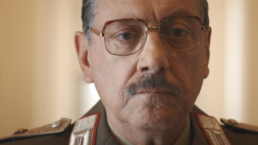“A man is hit when he is left alone.”
– General dalla Chiesa’s uneasy premonition during an interview with Giorgio Boca
The General’s Men (Il Nostro Generale) is an eight-episode Italian political crime thriller. Interwoven with newsreel footage, the series is a dramatization of the historical and political events spanning the turbulent decade of Italian history in the life of Prefect and Carabinieri General Carlo Alberto dalla Chiesa from 1972-82.
Conceived by Lucio Pellegrini, who also directed with Andrea Jublin, the action begins with the General’s death on September 3rd,1982 in Palermo, flashing back to the beginning of his last ten years. The directors demonstrate rock-solid storytelling techniques through their abilities to get the most heart-pounding and credible performances from the actors – most notably – Sergio Castellitto as ‘il Generale’ and Antonio Folletto as ‘Nicola.’ (Folletto narrates the series and also stars as Marco Aragona in The Bastards of Pizzofalcone on MHz Choice.)
Promoted to General after cleaning up Northern Italy of Mafiosi and other domestic terrorists, dalla Chiesa (Sergio Castellitto, Conclave) is transferred back to Palermo where the Mafia hitmen, Calogero Ganci and Antonio Madonia, fired 30 rounds with Kalashnikov AK-47 rifles at his car killing him, his wife and escort officer, Domenico Russo. This tragedy happened on the heels of the Aldo Moro kidnapping and assassination as depicted in another Italian political thriller on MHz Choice, Exterior Night.
Il Generale’s Rise to Prominence
Carlo Alberto dalla Chiesa (1920-1982) was born in Saluzzo, Italy to Romano dalla Chiesa, a prominent Carabinieri officer. He studied law and political science at the University of Bari (named Bari Aldo Moro after the Prime Minister’s assassination) after serving in the Italian army and the Carabinieri from 1941-82. During World War II, he was a member of the Italian Resistance, fighting on both the Yugoslavian and Italian fronts. He was awarded the Liberation War Volunteer Badge and the Silver Medal for Military Valor.
Dalla Chiesa quickly rose through the ranks becoming Turin’s Military Commander with special powers, allowing him to create a special paramilitary unit — the “Anti-Terrorism Unit” that actively fought the Red Brigades/Brigate Rosse (BR) with surveillance, photography, infiltration, check points and a special cadre of single men and one woman: Nicola Amato (Antonio Folletto), Minnie (Viola Satoretto), Pasquale Trucido (Andrea Di Maria), Captain Umberto Bonaventura (Alessio Pratico), Tedesco (Stefano Rossi Giordano), Flavio Furno (Gian Paolo Sechi), Enrico R. Galvaligi (Roberto De Francesco), Roberto Peci (Gianluca Zaccaria), Silvano Girotto – the infiltrator (Daniele Mariani), and Mareshallo Maritano (Rosario Lisma).
The success of dalla Chiesa’s Special Unit prevented countless murders and other crimes by making hundreds of arrests, televising trials and handing out prison sentences which made the Italian populace feel secure. The general’s popularity and the Unit’s success, however, ultimately resulted in its disbandment (Minnie went back to work for the police; three special agents went to Turin, and three others went to Rome) at a crucial time in Italy’s history when senior police and Carabinieri officials believed that the BR only operated in industrial cities — not in Rome. Then the assassinations of Brigate Rosse defense lawyer Fulvio Croce and prosecutor Francesco Coco, along with violence against and murders of anti-BR journalists and editors, resulted in a frightened populace.
Brought back into service as head of prison security, dalla Chiesa lived primarily in Milan. Lax prison security allowed Renato Curcio to slip away from the police during a prison transfer. The General made surprise visits to each prison and opened five, high-security prisons for BR terrorists and Mafia members.
Promoted to Prefect of Palermo, dalla Chiesa was ordered to stop the Mafia’s control over Sicilian citizens and businesses. His acceptance of this position was tied to the passage of Congressman Pio La Torre’s Law which made association with the Mafia a crime. When the Rognoni-La Torre Law (after La Torre’s murder) finally passed, the violence continued as Mafiosi murdered each other as well as “pentitos” (those who turned state’s evidence). In the early 1980s, Judges Giovanni Falcone and Paolo Borsellino convicted 388 Cosa Nostra members. Car bombs killed Falcone on May 23rd, 1992 and Borsellino on July 19th, 1992 – as dramatized in the two-part limited series Giovanni Falcone on MHz Choice.
Conjecture has it that Mafia boss, Tommasso Buscetta (Ninni Bruschetta) contacted the Brigate Rosse while in prison to stop dalla Chiesa.
Monica Zapelli created and co-wrote the screenplay with Peppe Fiore based on Giovanni Bianconi’s historical research. The writers evoke the interplay between the personal stories –the revolutionaries committed to destroying the status quo, as well as the organized crime figures committed to keeping the status quo’s accepted entrenchment of all manners of corruption. Cinematographer Marco Bassano’s muted palette infuses the action with black and white newsreel footage, while the elegiac tonality of the music by Giuliano Taviani and Carmelo Travia is a harbinger of things to come throughout.
Fascism and the Mafia in Italy
General Carlo Alberto dalla Chiesa fought two implacable extremist groups without continuous political, police and financial support. As a soldier and Resistance fighter, he saw innocent blood spilled by ordinary citizens and upholders of the law during the establishment of Italy’s democratic government giving equal rights to all citizens.
Jeffersonian ideals took root in the rich, fertile Italian soil. However, Italy’s post War Boomer generation became afflicted with guilt at the treatment of blue-collar workers, farmers, peasants without money, education, trades or skills who became hopelessly impoverished while the upper-class businessmen, industrialists and politicians made huge profits.
Italy – the birthplace of Fascism (Mussolini coined the word in 1919) – is a crucible of far-right and far-left political innovations. Mussolini – the template for strongman corruption presented Fascism as a cleanser of war profiteers and anti-Fascists involved in organized crime. The Sicilian Mafia and similar organizations were a threat because they were substitutes for state power in agrarian areas where they siphoned off state funds. In 1925, Cesare Mori (the subject of another MHz Choice series) successfully arrested thousands of Mafiosi, getting him fired in the process. The Fascist Militia – rather than controlling the Mafia – adopted their methods and operated under state authority.
The middle-class parents of the afflicted, guilt-ridden students were at a loss when their privileged children fought for the disenfranchised and struck a pact with the Mafia whose tentacles of bribery and corruption led to the highest corridors of power. Although the Brigate Rosse wanted a more egalitarian form of government believing communism the answer, the Mafia – in existence since the 19th Century in Sicily and in other Italian cities – would spread its tentacles unchecked throughout every sector of Italian society.
More about The Brigate Rosse
The Brigate Rosse operated from the 1970s – October 23rd, 1988. Its far-left, Marxist-Leninist ideology united students with workers seeking better working conditions, better pay and health insurance, shorter workdays and one day off each week along with better safety conditions in Italy’s industrial North. By 1981, the BR had split into two factions: the majority Communist Combatant (Red Brigades-PCC) led by Barbara Balzerani and the minority Union of Combatant Communists (Red Brigades-UCC) led by Giovanni Senzani who was captured on January 9, 1982.
Founder Alberto Franceschini (b. 1947), whose grandfather founded the Italian Communist party in 1920, was captured and imprisoned in 1975 and released in 1992.
Margherita (Mara) Cagol and her husband, Renato Curcio (b. 1941), were also co-founders and Curcio was responsible for Aldo Moro’s kidnapping and murder. The death of Curcio’s favorite uncle (a Fiat auto worker) in a Fascist ambush, led to his membership in “Jeune Europe” (the neo-Fascist Euro-nationalist movement). The bloody demonstrations at Trento and the police massacre of farm workers radicalized him. In 1976, he was tried, convicted and imprisoned. In 1998, Curcio was freed. His wife, Mara Cagol (1945-75), came from a well-to-do middle-class family, married Curcio in a Catholic ceremony, and along with her husband became an extremist. On February 18th, 1975, she freed her husband from prison. She was shot by Carabinieri during a gunfight and attempted escape. Her husband was recaptured.
Mario Moretti (b. 1946), a leading BR member, was formerly a student and worker at Sit-Siemens where he met Corrado Alunni, Giorgio Semeria and Paola Besuschio. He was one of Aldo Moro’s kidnappers. He confessed to killing him, which is under dispute even though he was the only one to speak to him. His middle-class, right-wing family background led to his lies about being a leftist and a member of the proletariat. He introduced member separations to reduce the consequences of arrest. He received six life sentences, but in 1998 he was allowed to work outside of prison as long as he returned every night and on weekends.
Corrado Alunni, a member of BR’s predecessor, Prima Linea, which operated from 1976-83 as a Communist/Marxist-Leninist, militant anti-Fascist organization was closely allied with Fiat workers as they made headlines on November 29,1976 when three men and three women stormed Fiat HQ, chained employees, stole money and spray painted the name, Prima Linea. While the violence increased, Alunni was captured on September 13th, 1978 while in hiding. Sentenced to more than 50 years in prison in 1987, he received a conditional release in 1989 after publicly ‘dissociating’ himself from his revolutionary activities.
A Brief History of the Mafia
The term Mafia (refers to any criminal organization; it was originally coined by the press; Japanese Mafia – ‘Yakuza’ and the Russian Mafia – ‘bratva’), originated with the Sicilian Mafia referred to originally as the “Cosa Nostra.” Their activities centered on arbitrating criminal disputes by enforcing illegal agreements between crime families and criminals through control of loan sharking, gambling, drug trafficking, prostitution, fraud, blackmail, racketeering, extortion and political patronage.
The Italian American Mafia traces its roots to the “Camorra” – the 18th Century criminal society in feudal Campania which controlled Naples, Caserta and Salerno as well as other regions in Italy and in foreign countries. In Naples, the Camorra developed into small criminal gangs. Royal decree authorized eight gambling houses in 1735 Naples where the words ‘capo’ (boss) and a Neapolitan Street – the Morra were blended. During prohibition, some bosses extracted protection money against police raids. In 1820, police documents record a Camorra tribunal, funds for families of imprisoned members and initiation rites. The Camorra kept the poor in line by aiding the police and aristocratic landowners in 1869. Its horizontal structure differed from the Sicilian pyramid.
Camorra clans regroup or reorganize upon a boss’ death or arrest resulting in frequent feuding. Drive-by shootings are common, but the code of silence – ‘omerta’ – makes crimes difficult to investigate and to prosecute.
The Camorra has ties to Nigerian drug gangs, the Albanian Mafia and allow two foreign clans – Lagos and Benin City – to traffic cocaine and women as sexual slaves.
The “Ndragheta” originated in 19th Century Calabria with a decentralized, horizontal structure based on family and blood. They are connected to families in northern Italy, Lazio, Australia, Canada and in other countries. Their money comes from drug/weapons trafficking, racketeering, loan sharking, money laundering, murder and kidnapping, robbery, fraud and extortion. (In 1973, John Paul Getty III’s kidnapping and severed ear made headlines around the world.)
Further Watching
Film:
100 Days in Palermo (1984)
Placido Rizzotto (2000)
Reliving Carlo Alberto dalla Chiesa (2012)
Series on MHz Choice:
Exterior Night
Mafia Only Kills in Summer
Giovanni Falcone
Criminal Milan
Cesare Mori
Further Reading:
Imperfect Crime: The General, the Mafia, Italian Society, Nando Della Chiesa. Arnoldo Mondadori Editore (1984).
Mafia Crimes, State Cover-Ups: The Connections Between the Mafia, Fascist Extremism and Deviant Institutions in the Mattei, De Mauro, Verzotto and dalla Chiesa Affair. Eigidio Ceccato (Castelvecchio, Rome, 2020).
Strongmen: Mussolini to the Present. Ruth Ben-Ghiat (W.W. Norton & Co., 2021).
EDITOR’S NOTE: We happily discovered Dr. Pearl Brandwein while reviewing MHz Choice subscriber feedback on our programs and, after reading a half dozen or so of Dr. Brandwein’s insightful reviews, all of us here at MHz Choice had the same thought: We need to get the good doctor to write for us! Enjoy! -MHz Choice
About the author:
A lover of Romance languages and cultures, Dr. Pearl Brandwein has a Certificate in French Culture and Civilization from the Sorbonne. She then earned both her Masters’ degree in French Language/Literature and Ph.D. in Comparative Literature from New York University. Dr. Brandwein’s areas of academic expertise include the Renaissance and the Faust Figure in European Literature in addition to 19th and 20th Century Drama. Her other interests include writing about Holocaust Literature.
Dr. Brandwein began her teaching career at Princeton University followed by faculty positions at other academic institutions. In addition to French, she has also taught German, Latin, English Composition and ESL to corporate executives. After academia, she held numerous positions in the public and private sectors working as an Editor/Instructor/Administrator and as a PR professional and business communications executive directing editorial and marketing initiatives for EU clients.
She is a cineaste and a lover of Film Noir, Westerns and foreign films as well as a theatre and opera buff; she also attends concerts, lectures, ballet performances, museum and gallery exhibitions. In her rare spare time, she reads voraciously.
Want to get MHz Choice Premiere announcements sent to your inbox?
Sign up for our free newsletter here!
MHz Choice is available in the U.S. & Canada. Free 7-day trial then $7.99/mo.
Subscribe at mhzchoice.com.







